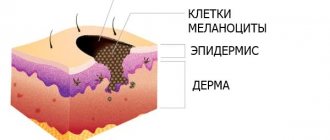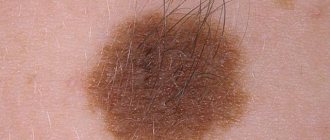When should a mole be removed?
If a mole changes shape or surface structure, causes discomfort, is damaged, or is too exposed and vulnerable, it is recommended to remove it
If a mole changes shape or surface structure, becomes uncomfortable, is damaged, or is too exposed and vulnerable, it is recommended that it be removed. It should be remembered that a mole is not always a harmless purely aesthetic problem. A consultation with a dermatologist is required, who will examine the mole using a dermascope and determine whether it needs to be removed and how. Unnecessarily removing all moles in a row is not beneficial to health and can leave scars on the body. Contraindications to mole removal are exacerbations of chronic diseases, unhealthy appearance of the skin area around the mole, as well as cardiovascular diseases.
Location of the procedure, cost
Doctors recommend refraining from removing the nevus yourself. Carrying out such a procedure at home is traumatic and unsafe. Unskilled exposure can lead to the degeneration of the formation into a cancerous tumor. Only after undergoing an examination at the clinic and making sure that the mole is benign can you remove it.
Small nevi can be eliminated in a beauty salon. Hanging formations and birthmarks that occupy a large area should be removed by an experienced dermatologist in the clinic. Laser equipment is now available in public and private medical institutions. Anyone can independently choose where to remove a mole. For the convenience of patients, the clinic will offer an appointment by phone, and the procedure itself will take a minimum of time.
You can also make an appointment and find out how much it costs to remove a mole on the face on the clinics’ website. Today this procedure, even in large cities, is not expensive. The price for removing small formations starts from 200 rubles. The exact cost depends on the size of the nevus and its location. For example, if moles are located on the eyelids, they can be removed for 1000 rubles. In particularly difficult cases, you will have to pay 3,000 rubles. or a little more.
How is mole removal done?
The procedure for removing tumors is based on the principle of photoselectivity: different components of biological tissue absorb light waves of a certain length differently. Thus, for a carbon dioxide laser, the target (chromophore) is water molecules. Since a living cell consists of approximately 76% water, when radiation is absorbed, the radiation energy is converted into the internal energy of water molecules with their instant evaporation, i.e. the neoplasm cells are not burned out (as many naively assume), but rather evaporate. A specialist, acting on a mole or any other neoplasm with a laser, removes it layer by layer from the surface of the skin.
The SmartXide carbon dioxide laser (“DECA”) allows for very precise control of the process, laser depth and intensity to eliminate the possibility of damage to healthy skin.
To remove tumors that have a vascular component, a Synchro FT neodymium laser (“DECA”) is used, which coagulates the vessels that ensure the growth of this unwanted formation.
Mole removal methods
Electrocoagulation is performed using a special surgical coagulator
Electrocoagulation.
Removal of moles by this method is carried out using a special surgical coagulator. Local anesthesia is used. The mole is cut off by high frequency current, which simultaneously solders the tissue. This avoids bleeding and infection of the wound. After electrocoagulation, the cut material can be examined. A small crust forms at the site of the mole, falling off after 7-10 days, sometimes leaving a barely noticeable scar. The method is effective for removing small moles on the face and body.
Cryodestruction.
For moles that involve only the upper layers of the epidermis, removal with liquid nitrogen - cryodestruction - is suitable. Removal of flat moles is carried out with a cotton swab, which is pre-wetted in liquid nitrogen. The application lasts no more than 3 minutes. During the procedure, a slight numbness is felt at the site of treatment, but there is no pain. In case of deeper germination of moles, a cryodestructor is used. A special ultra-thin needle with a temperature sensor is inserted deep into the skin. After insertion, the needle is cooled to a predetermined temperature and removed almost immediately. In the first few days after the procedure, a rejection reaction of the treated pigmented tissue begins. A crust forms, which falls off and heals within a month and a half. The procedure is contraindicated in case of individual intolerance to cold.
Laser removal of moles.
The tool for removing a mole in this case is a powerful light beam, which destroys its cells and evaporates them from the skin. Neighboring tissues are not affected, so burns are excluded. The procedure is bloodless and is performed under local anesthesia.
Laser flow parameters must be selected individually.
The tissue evaporation treatment is carried out in layers and is completed to achieve healthy skin without touching it. A crust forms at the treatment site after a few days, which disappears after one to two weeks.
Radio wave removal of moles.
Removing moles with a radio knife is a non-contact, non-traumatic method based on the possibility of coagulation and tissue cutting with high-frequency radio waves. It is characterized by rapid healing - the crust disappears after a week. Contraindications to radio wave removal of moles are the presence of a pacemaker in the patient, as well as herpes and a feverish condition.
Surgical removal of moles.
The most reliable method, suitable for removing large formations against which other methods are powerless, as well as “hanging” moles. Removal of dangerous moles is best done surgically.
The procedure has virtually no contraindications and is performed under local anesthesia. The mole is excised with a scalpel and removed, including a small area of healthy skin. The surgery may leave a large scar that will take several weeks to heal. Although the procedure is quick, the wound requires care for a long time. To remove small moles on the face, it is wiser to choose other methods, if possible.
"Folk" methods.
Currently, many different natural-based ointments are advertised, designed to eliminate skin defects - warts and moles. They can be bought without a prescription or a doctor's prescription, but the responsibility for the effect produced will lie solely with you. It is better not to risk using such a product to remove moles, but to consult a doctor. It is strictly forbidden to cut or burn moles yourself.
Stages of healing
The first stage of healing lasts the first seven days, during which the crust gradually darkens and becomes more rigid. You should never touch it, as it protects the wound from infection and promotes the appearance of new healthy tissue. In the first week after the procedure, the operated area should be protected from any injuries and damage; it should not be covered with clothing too often, wetted with water or rubbed with a washcloth, scratched or applied with any cosmetics.
The use of disinfectants is allowed if they have been prescribed by a doctor. You can also treat the crust with a mild solution of potassium permanganate.
The next stage of healing includes the second week after surgery. During this time, the dark crust at the site of the former mole disappears on its own, and light pink skin remains instead. It is still recommended to protect this area from any excessive exposure as well as ultraviolet rays. To this end, it is worth reducing the time spent in the open sun, as well as treating the skin with sunscreen with a maximum protective factor (about SPF 50). Young skin can become significantly pigmented when exposed to the sun, especially on the face.
The final stage of recovery lasts 14 to 20 days after surgery or more. By this time, completely healthy skin has formed at the site of the removed mole, which has protective factors from ultraviolet radiation and other external influences, including mechanical ones. A slight itching may persist, which can be relieved with soothing ointments. Otherwise, skin surface care is no longer required.
If a hole remains at the site of the removed lesion, do not worry: usually the skin smoothes out on its own over the next 1-2 months.
Benefits of tumor removal
Laser removal of skin defects, such as moles, using a fractional CO2 laser has a number of advantages:
- Absolute sterility of the procedure, because the procedure is contactless, i.e. no additional sanitation required;
- The laser beam of both CO2 and neodymium laser provides coagulation of blood vessels at the site of exposure, i.e. the procedure for removing tumors is absolutely bloodless;
- The features of the SmartXide DOT laser allow you to successfully work on any hard-to-reach (nose, ear, perineum) and particularly sensitive (eyelids, intimate areas) areas of a person;
- The doctor fully controls the process of removing benign tumors - the depth and level of destruction of skin tissue - after such removal there are no scars;
- Epithelization and complete healing of wounds occurs much faster (compared to electrocoagulation and cryodestruction).
The likelihood of developing unforeseen consequences after removing a mole
Laser correction of moles is one of the safest ways to get rid of nevus, avoiding complications and unforeseen consequences
Laser correction of moles is one of the safest ways to get rid of nevus, avoiding complications and unforeseen consequences. A beam of directed light radiation literally evaporates the pigmented cells of moles, which is visually manifested by the complete removal of the epidermal formation in just a few minutes. Minimization of negative consequences occurs due to the following objective factors.
- The laser beam acts in a strictly targeted and selective manner, without injuring healthy skin structures, which allows the technique to be used even to remove the smallest nevi in the eyelid area and mucous membranes;
- There is virtually no risk of infection, since the laser exhibits a powerful antibacterial and antimicrobial effect, protecting the wound surface from infection;
- Laser destruction is not accompanied by bleeding or hemorrhage, since during the manipulation process all blood capillaries supplying the body of the mole undergo thermal coagulation;
- The laser activates regenerative processes in the skin, which significantly accelerates wound healing;
- The technique is low-traumatic, which avoids the formation of connective tissue and all the negative consequences associated with this factor.
Despite the safety of the method, it should be borne in mind that before the procedure it is necessary to carefully study the list of contraindications, since the consequences and complications of laser correction most often result from neglect of this list, which includes the following conditions:
- Pregnancy;
- Acute infectious process;
- Oncology of any localization;
- Inflammation in the intended area of laser exposure;
- Period of menstruation in women;
- Immunodeficiency;
- Exacerbation of chronic pathologies;
- Hyperthermia.
Injection of an anesthetic drug under the skin
Any local anesthetic drug causes an unpleasant tingling or burning sensation when it enters the skin through the needle. This is due to the fact that the drug pushes the tissues apart and has an irritating effect on them. In this case, a characteristic “button” forms on the skin.
In order to smooth out this moment, we use the most modern drugs for local anesthesia. They provide excellent pain relief using a minimal amount of substance. The smaller volume pushes the tissues apart less, the injection time is shorter, and the pain is less.
Current issues
Most patients, after undergoing a laser mole removal procedure, observe some characteristic reactions of the body during the first two weeks, some of which are normal responses that are compensatory in nature.
Let's consider several pressing issues regarding the consequences of removing nevi on the face and body. Can cancer occur after mole removal? Skin cancer, or melanoma, usually develops as a consequence of the malignant transformation of a melanoma-prone mole. Moreover, if during the laser correction process the specialist incorrectly determined the required depth of the beam and did not completely remove the mole, the risk of developing melanoma increases.
After removal, a tubercle appeared. Despite the low-invasiveness of the technique, in the process of removing the nevus, healthy surrounding tissue remains, which will have to undergo the healing process of the wound surface that has formed in place of the mole. In this case, this zone can form a small tubercle, which will be covered with a dense crust in a few days. This is considered a normal reaction to manipulation.
Inflammation after removal of a birthmark. The inflammatory process after laser correction usually lasts for the first days, after which it goes away. If inflammatory signs persist for a long time, you must immediately contact the specialist who performed the procedure.
Can a scar or scar form after removal of a nevus? The formation of scars can only be observed in the case of forced premature removal of the protective crust from the wound surface.
The scar itches and hurts after mole removal. Itching, burning, peeling and redness around a mole after removal are characteristic symptoms of a burn, which can be caused by unprofessional work of a doctor. This unpleasant complication develops if the specialist incorrectly determined the depth of exposure and subjected healthy skin cells to laser burning.
Care after laser mole removal
If the laser ablation procedure was performed by a qualified specialist, the risk of side effects is minimal, but the patient will also have to follow certain post-procedure rules, listed below.
- It is necessary to provide rest to the wound surface, without injuring it by friction of clothing or shoes, and also by taking care of the protective crust;
- Contact of the wound with water should be avoided for two weeks after manipulation;
- It is recommended to protect the skin surface from direct sunlight, and also use creams with a high UV protection factor. To the question of when you can sunbathe after removing a mole, the answer will be at least three weeks;
- You cannot use ointments, creams and gels for healing on your own without a doctor’s prescription;
- The procedure area should be protected from any mechanical damage, carefully protecting the integrity of the protective scab.
Laser removal is one of the simplest and least traumatic methods of mole destruction. Compliance with simple rules of rehabilitation will allow you to avoid scars, cicatrices and other unpleasant consequences and obtain an ideal physiological and aesthetic result.
How to remove a nevus at home?
Extreme types of impact (cutting, tearing off) should be completely excluded, as this is fraught with the development of cancer.
For removal at home use:
- garlic
- iodine
- ointment with celandine
- vinegar, apple juice
In all these cases, a cotton pad is moistened and used to lubricate the nevus. All folk remedies require a huge amount of time, and the consequences can be unpredictable.
Thus, nevi are neoplasms that can cause harm if handled incorrectly. Therefore, the treatment method is chosen by the doctor who decides on the need for a histological examination.











